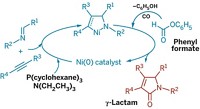Advertisement
Grab your lab coat. Let's get started
Welcome!
Welcome!
Create an account below to get 6 C&EN articles per month, receive newsletters and more - all free.
It seems this is your first time logging in online. Please enter the following information to continue.
As an ACS member you automatically get access to this site. All we need is few more details to create your reading experience.
Not you? Sign in with a different account.
Not you? Sign in with a different account.
ERROR 1
ERROR 1
ERROR 2
ERROR 2
ERROR 2
ERROR 2
ERROR 2
Password and Confirm password must match.
If you have an ACS member number, please enter it here so we can link this account to your membership. (optional)
ERROR 2
ACS values your privacy. By submitting your information, you are gaining access to C&EN and subscribing to our weekly newsletter. We use the information you provide to make your reading experience better, and we will never sell your data to third party members.
Synthesis
New System For Aerobic Oxidations
Catalysis: Bimetallic nanoclusters and catechol stand in for a metalloenzyme and its cofactor
by Stephen K. Ritter
August 17, 2012
| A version of this story appeared in
Volume 90, Issue 34
Natural metalloenzymes and their small-organic-molecule cofactors are model cooperative catalytic reaction systems that chemists like to emulate when trying to improve the efficiency of organic syntheses. Shū Kobayashi and coworkers at the University of Tokyo have now demonstrated the first example of a heterogeneous nanocluster catalyst cooperating with an organocatalyst cofactor. The pairing enables amine oxidations to be carried out under mild reaction conditions (J. Am. Chem. Soc., DOI: 10.1021/ja306934b).
Cooperative catalysts are typically homogeneous systems involving a soluble transition-metal complex and a small organic molecule. The two work together to overcome energy barriers along the reaction pathway, enabling high reactivity and enantioselectivity that neither catalyst can accomplish on its own.
Kobayashi’s group previously developed bimetallic nanoclusters “incarcerated” in a styrene-based copolymer support material. Although these immobilized metal nanocluster catalysts are highly effective in facilitating some types of aerobic oxidations, they have had limited utility in converting amines to imines because they require high temperatures, Kobayashi says.
The Tokyo researchers have now tested their incarcerated catalysts on the oxidation of amines to imines using platinum-iridium nanoclusters with 4-tert-butylcatechol as the cofactor, a system that mimics the action of amine oxidases. They converted dibenzylamines to the corresponding imines in air at room temperature in up to 90% isolated yield, recycling the nanocluster catalyst five times without loss of activity. In a bonus finding, Kobayashi’s team discovered that the catalyst system can convert secondary amines to imines—natural metalloenzyme-cofactor systems can’t do that.
Mechanistic studies suggest that the catechol and amine form a quinone complex that binds to the nanocluster surface. This bound intermediate then undergoes hydride transfer from the amine to the nanocluster to generate the imine C=N bond.
“Transition-metal-catalyzed oxidations to dehydrogenate aliphatic amines to imines require vigorous reaction conditions,” comments Chul-Ho Jun, a specialist in metal-organic cooperative catalysis at Yonsei University in Seoul, South Korea. The synergistic action of this unique heterogeneous cooperative catalyst lowers the activation energy to overcome that problem, Jun adds.





Join the conversation
Contact the reporter
Submit a Letter to the Editor for publication
Engage with us on Twitter